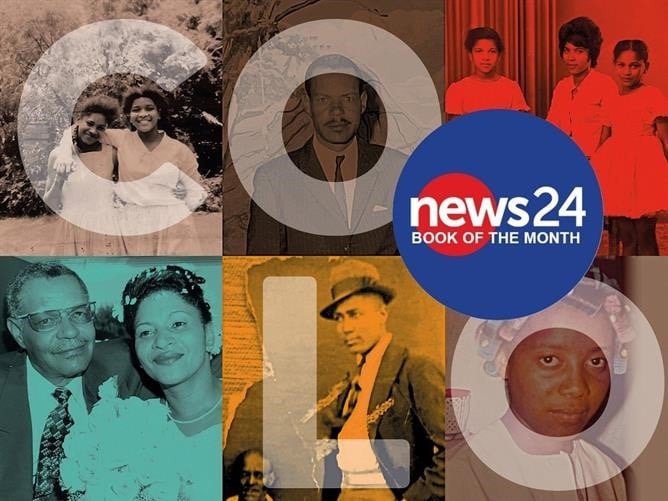
Coloured as an ethnicity and racial demographic is intertwined with the creation of today’s South Africa. Yet often coloured communities are disdained as people with no clear heritage or culture – as not "black enough" or "white enough". Coloured by Tessa Dooms and Lynsey Ebony Chutel, challenges this notion and presents a different angle to that narrative. It delves into the history of coloured people as descendants of indigenous Africans and a people whose identity was shaped by colonisation, slavery, and the racial political hierarchy it created.
Although rooted in a difficult history, this book is also about the culture that coloured communities have created for themselves through food, music, and shared lived experiences in communities such as Eldorado Park, Eersterus and Wentworth. Coloured culture is an act of defiance and resilience. The book is a reflection on and celebration of coloured identities as lived experiences. It is a call to coloured communities to reclaim their identity. In this excerpt, Dooms and Chutel explain the thinking behind their book.
BOOK: Coloured: How Classification Became Culture by Tessa Dooms and Lynsey Ebony Chutel (Jonathan Ball)
In 2020, the death of yet another Black man in the United States sparked global outrage and solidarity with the #BlackLivesMatter movement. George Floyd’s death, in full public view and recorded as a White police officer would literally not take his knee off the cuffed man’s neck, brought home the enduring racial inequality not only in the US but also in Europe, South America and Asia. It was a reminder that, in many of these countries’ Black neighbourhoods, the police are an extension of a system designed to oppress people of colour.
Across the Atlantic, 16-year-old Nathaniel Julies, a Coloured boy, was shot at point-blank range by a police officer while returning home from the local shop in Eldorado Park, a township southwest of Johannesburg. Just as the racist tropes of African Americans created the environment for Floyd’s killing, Julies was a young Coloured man, in a Coloured neighbourhood, trapped by tropes of violence and gangsterism. Except Julies had Down syndrome and was well known in the community as a harmless, helpful and generally pleasant child. Yet somehow, his very presence posed a threat so great that it required lethal force. The officers accused of killing Julies were Coloured and Black, an awful reminder of how the South African policing system is inherently hostile to people of colour, irrespective of the race of the officers. And while we still don’t know the motive behind the killing, it’s hard not to see this as a form of internalised racism, an example of how little a Coloured boy’s life mattered even to the people who look like him.
The wave of anger about police brutality quickly spread from Eldorado Park to the rest of the country. Soon, other townships joined, and the protests took on a greater significance to become a demonstration against the hopelessness and nihilism of young Coloured people who felt left behind by a system that was meant to take them into a non-racial future. Soon, #ColouredLivesMatter began to pop up on social media and on the placards people carried as they marched to the police station. As the issue gained national attention, Tessa Dooms, a sociologist and political analyst, was called in to news broadcast studios to help South Africans understand the anger they saw unfolding on television in the dramatic clashes between community members and police. Lynsey Ebony Chutel, a journalist, was assigned to the story to talk to the grieving family, the community and the police in an attempt to understand what had happened and what the moment meant.
Both of us also happen to be Coloured women who grew up in Eldorado Park. In our professional roles, we found ourselves trying to translate our childhood communities, but also their present-day frustrations, while positioning it all in a global movement to explain how the hashtag #BlackLivesMatter had been subverted into a very specific ethnic – but still Black – identity.
Explaining the nuances between these positions is difficult on an ordinary day, but doing so in a context of high emotions, in the glare of the media as the country – and the world – watched and listened, was a much harder task than we imagined. The terms "Black" and "Coloured" mean so many things to so many people that a crude one-liner in a news report or radio interview cannot do them justice – and made contributing to public discourse a daunting experience. It was in the midst of this struggle to do justice to a complex story of one Coloured family’s pain and one Coloured community’s anger that the idea of this book was conceived.
ALSO READ | Coming to FLF: Adam Welz to speak on the future of humanity and climate destruction
To begin to explain the alienation of young Coloured people today, we had to look back to the creation of this community, in whose fractured history is the story of South Africa itself. We hoped to begin by responding to the base question: what, if anything, distinguishes Coloured identity from that of other groupings of Black people? This led to many more questions that too few people ask about what it means to be Coloured in South Africa.
Not nearly enough has been written about Coloured identity in South Africa historically, and certainly not about the contemporary experiences of Coloured people in the context of a post-apartheid society seeking to redress the injustices of our brutal past and build a more equitable society into the future. Mixed-heritage and creolised people’s stories, the world over, are generally found on the margins of history. The stories of these communities are often deemed too opaque, complex, revealing of malevolence that others would prefer to remain hidden, and even inconvenient among other oppressed groups fighting for their own right to be heard and seen in the struggle for justice and power.
Yet there are many books about race: about what race and racism are, about how systems of racism define and confine people and strip them of their voices and places in the world. Each of those books has some relationship to normative ideas about how Coloured identity can best be understood. Books that are more specifically about slavery, colonialism and apartheid shed further light on the making of Coloured identities. While all useful, not many of these offerings of reflection and analysis can – or should – replace the understanding of Coloured identity as experiences rather than historical facts.
Coloured identity cannot be reduced to a racial classification, one that codifies people to legitimise or delegitimise them. Coloured identity is us. Coloured people, so identified by choice and by force, are not only the experts on Colouredness – we are the essence of what it means to be Coloured. Understanding Coloured identity requires people who are not Coloured to be willing to look beyond the stereotypes, listen past the generalisations, and look into the eyes, souls, hearts and minds of Coloured communities with a desire to learn. A deep need exists within Coloured communities not to be spoken about, or even spoken to, but to be seen and to be heard.
We offer this book, then, as a mirror to reflect Coloured life – and a projection to show this life to people who too often think they know us. It is a book for Coloured people, by Coloured people, a book of Coloured and colourful stories from varied corners of the South African vista, past, present and future. We have written this book not only to capture stories of Colouredness, but also to evoke those stories in efforts to welcome all who care to know that Coloured lives truly do matter.
The very word "Coloured" is loaded. To some, it is a slur, which made the hashtag even more controversial as it spread. To others, it is a burden. To others still, it is a unifier in a country where ethnic identity politics are beginning to replace the ideals of non-racialism and Black Consciousness that toppled apartheid. Who are Coloured people? Are they San or Khoe, Malay or mixed, and where in South Africa do they fit in? And then the enduring, but also insulting, question: do Coloured people even have a culture?
These are questions that we, the authors, have grappled with in our own lives, too. Our histories are so different, yet we are of the same ethnic group. Was being from Eldorado Park enough to make you Coloured? Not in the slightest. How about having mixed heritage? Most South Africans have a mixed cultural and ethnic heritage. To look at the markers of race – skin tone, hair texture, physical features – is to participate in the racism of White supremacy and the colourism that has already divided Coloured families and communities.
A harder question, still, to answer was whether we needed to be called Coloured at all. Many thought the classification would fall away along with the Colour Bar; not only has it held on, but a generation of so-called born-frees also clings to this identity. With so many wounds still gaping, so much healing still to be done, perhaps three decades after the end of apartheid was too soon to let go of four centuries of pain. But if we do hold on to this apartheid-era categorisation, what meaning will it take on?
We all know well enough that history is not neutral and that, at various epochs in the greater South African story, Coloured history and the question of identity have been used for the state’s political purposes. We hope that you will take the history in this book as an inspiration to explore your own, but also to deconstruct the mistruths that have peppered Coloured identity and kept us on the margins instead of recognising that our stories are the stories of this country. We need not ask who we are, because we have always belonged.
Our first conversation about writing this book was one of the shortest and clearest conversations we have had as friends and co-authors. A book about Coloured identity had been an ambition for us both for a long time. The prospect of writing it together gave us each great comfort as we could tackle this sensitive and intimidating mission within the confines of a trusted friendship. That friendship was a gift to this book. What we knew intuitively is that it could not be a book about ourselves. But as we dug through archives, interviewed Coloured South Africans and made sense of contemporary events, it became impossible to ignore our own stories. It became intensely personal and challenged our own long-held assumptions.
As we wrote, we also knew that this book needed to be about people, rather than about history or theory. But we use history in this book as a tool for understanding the present. There is certainly room for more theorisation of Colouredness as an identity and, although we reference some of the great theoretical debates in South Africa’s landscape about identity politics, this book is more about better understanding Coloured people’s realities than it is about abstracting their experiences in conceptual musings.
We ask you to read this book with your head and your heart. Take in the stories of Coloured communities from Limpopo to the Cape Peninsula with all the ebbs and flows of facts and feelings that make them accessible, even if you are not familiar with Coloured life. The people we interviewed have told many of these stories for the very first time. Even some of our own stories were spoken for the first time as we wrote this book. We are grateful that people trusted us with their deepest – and, in many cases, darkest – recollections.
We realise, too, that history can be murky at times; while we have endeavoured to give an accurate account, we still look forward to learning new or different information about the history of Coloured communities that will help advance the debates about the place of Coloured communities in our society.
If you are not a Coloured South African, this book is for you too. Consider it a guide through and into Colouredness from the most intimate view we could provide. You may know all the stereotypes, but we invite you to learn about the experiences of Coloured people – the food, music and languages that bring Coloured cultures to life. To experience the debates about hair and skin from inside our communities and understand how they are about so much more than aesthetics. To pay homage with us to the political heroes of Coloured communities, the internal contestations about power and the ongoing and ever-changing struggle for legitimacy and relevance in the broader national question. To peep through the keyhole of history and get a glimpse of the twists and turns that are the making and remaking of Colouredness, and of how these fit into South Africa today. We hope that, in the parallels we draw with the Black South African experience but also with African American and other international experiences of racial subjugation, you will find that we have more in common than segregationists would have us believe.
This is a story that begins in slavery and colonialism, and the forced labour and exploitation these necessitated. We examine apartheid and its laws, particularly its two most socially and economically destructive tools: the Population Registration Act and the Group Areas Act of 1950, which created a classification – Coloured – and applied it carelessly and at whim. The stroke of an apartheid bureaucrat’s pen wiped out the histories of entire communities, and forced removals invented new communities of convenience with no consideration of the people it forced together. We start, then, by attempting to animate the experience and consequences of apartheid classification, and move to explain the cultures that this classification lost and found through hair, music, language and food, and which constitute legitimate, albeit disparate, cultural experiences of Colouredness.
We cannot shy away from the social tensions that Colouredness represents in relation to other oppressed groups in South Africa, and we attempt to amplify as many voices and causes in Coloured communities’ intracultural political battles. Colouredness in South Africa has always been characterised by resistance, but at times these political formations existed to ensure proximity to Whiteness and a separation from Blackness. What does it mean when that form of political identity makes a resurgence? But most importantly, this book is a call to reclamation. It signals that the questions of the marginality of Coloured people are as valid as they are misleading.
While various iterations of Coloured identity have thrived on the idea of isolation, Coloured people, in all their guises, have never been marginal in an honest version of the South African story. Yet the response to Julies’s killing was once again wrapped in a narrative of isolation and marginalisation, of a forgotten people left to fend for themselves. The hashtag that set us off on this journey could be seen as yet another example of that marginality. But we have come to understand that it is the heartbreaking response of a people who feel erased from the South African story. Erasure is not a sign of marginality – it is an active attempt to keep salient stories out of the main narrative because they expose fissures in our society that are not easy to face or to fix.
It is our hope that this book will bring the subjugated but seminal stories of Coloured South Africans in the country’s past and present to the surface. That reading and discussing it will enable difficult conversations, within Coloured communities, between Black communities and, broadly, among people of the world who care about the direction in which the arc of history bends. South Africa, like many societies across the world, is grappling with what it will take to build a more just, more equitable society that delivers quality of life to all. If this book moves those endeavours forward, in even a small way, it will have been worth the effort.




 Publications
Publications
 Partners
Partners














